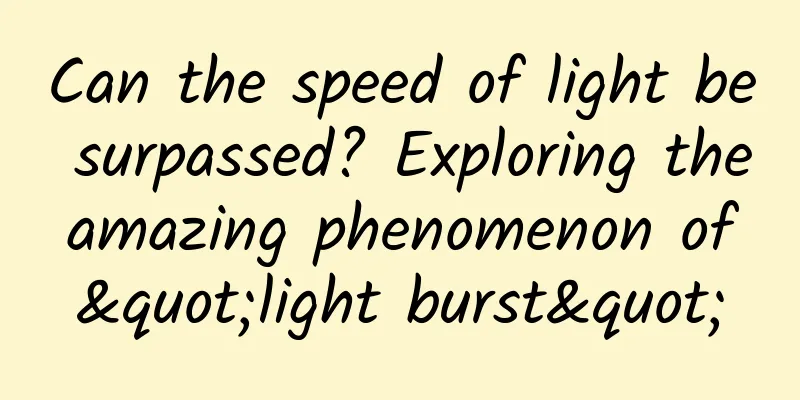Can the speed of light be surpassed? Exploring the amazing phenomenon of "light burst"

|
Since Einstein's special theory of relativity came out, the speed of light has become a very important constant in physics, namely c=299792458m/s. In other words, the speed of light is about 300,000 kilometers per second. Einstein believed that no object in this world, including microscopic and macroscopic objects, can reach the speed of light, let alone exceed the speed of light. Therefore, the speed of light has become an important parameter in many physics formulas, and many famous laws have been derived from it, such as the mass-energy equation E=mc², where E represents energy, m represents mass, and c represents the speed of light. In other words, energy and mass are equivalent and can be converted into each other. The mass of an object multiplied by the speed of light squared is the energy contained in the object. Einstein also derived the mass increase effect and time dilation effect of speed from the speed limitation of light. That is to say, the faster the speed during movement, the more obvious the mass increase effect. The distorted space-time will make the time pass slower. When the speed of light is reached, the momentum will become infinite and time will stagnate. This locks the speed of movement in our world, and it is impossible for any object to reach the speed of light, let alone exceed the speed of light. This law is expressed by two formulas, namely the mass increase effect formula: M=m/√[1-(v/c)^2], where M is the kinetic mass of the matter, m is the rest mass of the matter, v is the speed of movement, and c is the speed of light; the time dilation effect formula of speed: t'=t√(1-2GM/rc^2), where t' is the value of the gravitational time dilation effect, t is the time passage value of the observer in the low-gravitational inertial system, G is the gravitational constant, M is the mass of the celestial body, r is the radius of the celestial body, and c is the speed of light. All of the above illustrates a problem. In our world, the speed of light is the ceiling. No object can break through it. Not even a particle or a neutrino with almost no mass is an exception. Otherwise, the momentum will be infinite and the universe will collapse. Time will stagnate and everything will stagnate. This is the so-called light speed barrier. If so, why do we often see the phenomenon of "light explosion" introduced on the Internet, that is, the phenomenon of superluminal speed? We know that a sonic boom is a shock wave generated when an object moves faster than the speed of sound. It is because the sound waves generated by a supersonic object cannot be fast enough to leave the object, and the waves are "pile up" to form a shock wave front, also called a boom. The so-called light boom is the vibration wave generated when an object moves faster than the speed of light. Since the speed of light is the limit of the speed of movement in our world, and any object with rest mass cannot reach the speed of light, let alone exceed it, why does the superluminal phenomenon occur? This is because the so-called speed of light limit refers to the speed of light in a vacuum, that is, the speed of light c = 299792458m/s, which refers to the speed of light in a vacuum without a medium, and light will slow down in different media, such as about 1c in air, about 0.77c in ice, about 0.75c in water, about 0.73c in alcohol, and about 0.67c in glass. Therefore, any substance in a vacuum without a medium cannot reach the speed of light, let alone exceed the speed of light, but it is possible to exceed the speed of light in a medium. Of course, these so-called substances that exceed the speed of light in a medium can only be microscopic particles, such as neutrinos, which have extremely light mass and almost no electromagnetic force. Their movement speed is close to the speed of light. In this way, in media such as water, ice, and glass, their speed must exceed the speed of light. Neutrinos are not charged and will not interact with matter. Therefore, even though trillions of neutrinos pass through any fingernail-sized object every second, they will hardly leave a trace. However, one or two special neutrinos will collide with the nuclei of matter every few days. The hypervelocity collision will smash the nuclei and produce so-called subatomic "shrapnel", which will scatter from the collision point at a speed slightly lower than the speed of light. The speed of these "shrapnel" exceeds the speed of light, thus producing the "light explosion" phenomenon. In order to capture these neutrinos, scientists built the IceCube Neutrino Observatory in Antarctica. Unlike typical observatories, this observatory does not use large-aperture telescopes to observe space. Instead, it has more than 5,000 vertically suspended sensors 1.6 kilometers deep in the ice layer to capture the flashes that occur when neutrinos hit atomic nuclei, thereby determining where these neutrinos come from. "Photon burst" is also known as Cherenkov radiation, which is a type of short-wave electromagnetic radiation that mainly manifests as blue flashes. This phenomenon was discovered by the former Soviet physicist Pavel Alexeevich Cherenkov in 1934 and is therefore named after him. Cherenkov radiation is similar to the sonic boom phenomenon caused by supersonic flight, that is, when a charged particle moves at a speed exceeding the speed of light in the medium, a cone-shaped electromagnetic wave is generated in the medium, characterized by a blue glow, which is a light burst. The cone angle of this cone-shaped electromagnetic wave can be calculated using the formula cosθ=nvc. Where c is the speed of light in a vacuum, n is the refractive index of the medium, and v is the speed of the charged particle. From the formula, we can see that a light burst can only occur when the v value is greater than c/n. For example, the n value in water is approximately equal to 1.33, and we can calculate that the cone angle of the electron when v is 0.75c is approximately 49°. In practice, it is not only the subatomic fragments of neutrino collisions that can exceed the speed of light in a medium. There are also many particles that can move faster than the speed of light in media such as water and ice, such as the radiation phenomenon of nuclear reactions, particles accelerated by particle accelerators, cosmic rays, and so on. Therefore, we must strictly define the speed of light limit. The constant of the speed of light c=299792458m/s refers specifically to the speed of light in a vacuum. The speed of light in a vacuum is the so-called speed limit. No object can reach the speed of light in a vacuum. There is also a limitation, that is, objects with rest mass, even if this mass is extremely light and infinitely close to zero, such as neutrinos. The so-called superluminal phenomenon of light burst does not violate Einstein's theory of the speed of light limit. The speed of light in a vacuum is still the ceiling that cannot be broken by the speed of movement in the universe. This is an original article from Space-Time Communication. Please respect the author’s copyright. Thank you for your understanding and support. |
<<: Bird "hybrids" are rare enough, but how come there are also hermaphroditic birds?
Recommend
Is Baidu information flow advertising worth doing?
In the information flow advertising market, big p...
Waymo, the world's leading autonomous driving company under Google, has entered China. Can Baidu win again?
Amid the endless stream of news events, the news ...
Information flow effect is not good? 80% of the time, there is a problem with the landing page!
Seeing the world through our eyes is an innate ab...
If you want to live on the moon, you must understand these issues
Chairman Mao wrote in the poem "Shui Tiao Ge...
Excluding Guoxin factors, revenue increased by 18.3% year-on-year. Interpretation of the three major strategies behind NetQin's Q1 financial report
On May 27, NQin Technology Co., Ltd. (NYSE: NQ) a...
China's 40th Antarctic expedition team sets out to explore the sea! What will the new research station look like? How long will it take to be built?
On the morning of November 1st, with the sound of...
WeChat Mini Programs to attract traffic and promote, how to promote WeChat Mini Programs to attract traffic?
It is becoming increasingly difficult to do physi...
How to break the trick of using AI face-changing to defraud people?
With the continuous advancement of technology AI ...
2020 College Entrance Examination Encouragement Messages and Inspirational Messages to Encourage Children Taking the College Entrance Examination
The 2020 college entrance examination is coming s...
Luoyang! Luoyang!
Luoyang A name that goes deep into the Chinese sp...
The ancient staple food is sharing its "growth diary"! How many members of the rice family do you know?
An ancient staple food with a long history The ri...
What do scientists think of the Tonga volcano eruption?
The massive eruption of an underwater volcano in ...
Revealed! How is the national flag raised at Tiananmen Square accurate to the second?
New Year's Day Watch the flag-raising ceremon...
APP promotion methods: 10 methods to effectively increase APP download and registration rate!
On my first day at work in 2019, I was assigned n...
It is a "Beijing Drifter" and has gray hair at a young age.
For most struggling "Beijing Drifters",...









